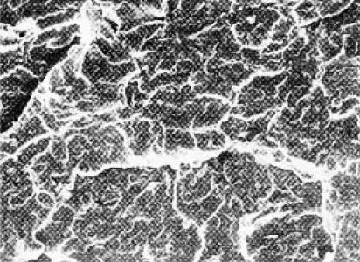Hydrogen embrittlement, also known as hydrogen-induced cracking, is one of the major defects in large forgings and occurs mostly in medium-carbon alloy steel forgings (martensitic steel and pearlitic steel). The larger the forging size, the easier the hydrogen embrittlement is formed. Special care should be taken when forging large steel forgings that are sensitive to hydrogen embrittlement, especially forgings such as rotors and impellers. Hydrogen embrittlement is characterized by a silvery spot having a circular or elliptical shape and a few to several tens of millimeters in diameter on the longitudinal fracture, and there is no plastic deformation in the vicinity of the silvery spot. The source of the crack is a smooth circular area parallel to the axis.

The microstructure at the HIC fracture of a mild carbon steel The white hairlines in the photo are the HIC fracture zone
The appearance of silvery spots is the result of precipitation of hydrogen absorbed in the molten steel during ingot solidification when steel making. Ingots and cast steels have many large internal pores that can accommodate air, and hydrogen does not cause large internal stresses when they are deposited. Therefore, it is not sensitive to silvery spots. After forging the part, the forging is internally compacted and the larger air-retaining pores are forged. During the cooling process, the precipitated hydrogen atoms combine with the constituents in some microvoids inside the forging (or react with carbon in the steel to form methane) and generate considerable pressure (when the mass fraction of hydrogen in the steel is 0.001%, at 400 °C, this pressure can reach 1200 Pa or more), the metal is bulged, generating and expanding cracks.
The formation of this kind of cracking is not only related to hydrogen, but also related to stress. Internal stress is generated when austenite transforms into martensite and decomposes into pearlite. Ferritic steel and austenitic steel do not undergo phase transformation when cooling, and there is no structural stress, so hydrogen embrittlement generally will not be generated. Although the ledeburite steel has large structural stress during cooling, the formation of stable hydrides and complex carbides in these steels hinders the precipitation of hydrogen, and does not produce silvery spots.
The accumulation of hydrogen atoms and crack propagation takes time. Hence, hydrogen-induced crackings are often produced after a few hours, or even longer after the forging has cooled to room temperature. For example, silvery spots will be not found in a 160-mm martensitic alloy structural steel billet within 72 hours. In addition, after the silvery spot begins to be generated, new silvery spots are continuously expanded and generated during subsequent cooling and placement. For this reason, the inspection of hydrogen embrittlement should be carried out after a while after cooling.
Since the silvery spot is mainly caused by the combined effect of hydrogen and structural stress in the steel, it is possible to avoid the generation of silvery spots by removing hydrogen firstly and then eliminating the structural stress. The most thorough approach is to start with the smelting process and reduce the amount of hydrogen in the steel to a value that does not cause silvery spots. Strict control of steel making operations, vacuum casting are very effective measures as well. If the hydrogen content in the steel making process cannot be controlled below 2cm3/100g, a reasonable hydrogen removal cooling specification must be adopted after forging, and the direct air cooling to room temperature in the final process is never allowed. If the steel processed by pressure has no silvery spot, then the spots will no longer appear on the forgings forged by these steel billets. To that end, for forging, the key issue is to develop a reasonable post-forging cooling specification.
The hydrogen content of large forgings is very uneven, increasing gradually from the surface to the center, which can be 1.5 to 2 times different. The effusion of hydrogen during slow cooling occurs only on the surface, and more hydrogen remains in the center. Therefore, in order to eliminate hydrogen embrittlement, the cooling of the large forgings should be slow, and the various stresses should be minimized. In the temperature range where the hydrogen diffusion rate is the fastest (550-600 °C), the isothermal annealing is performed for a long time to make the hydrogen can be fully diffused fro the steel billet. Products with high requirement should be processed at 550-600 °C to avoid hydrogen embrittlement.
As a professional piping supplier,our products contain steel pipes,pipe fittings and forged flanges.If you want to know more about our products,please feel free to contact us.Email:sales@haihaogroup.com







